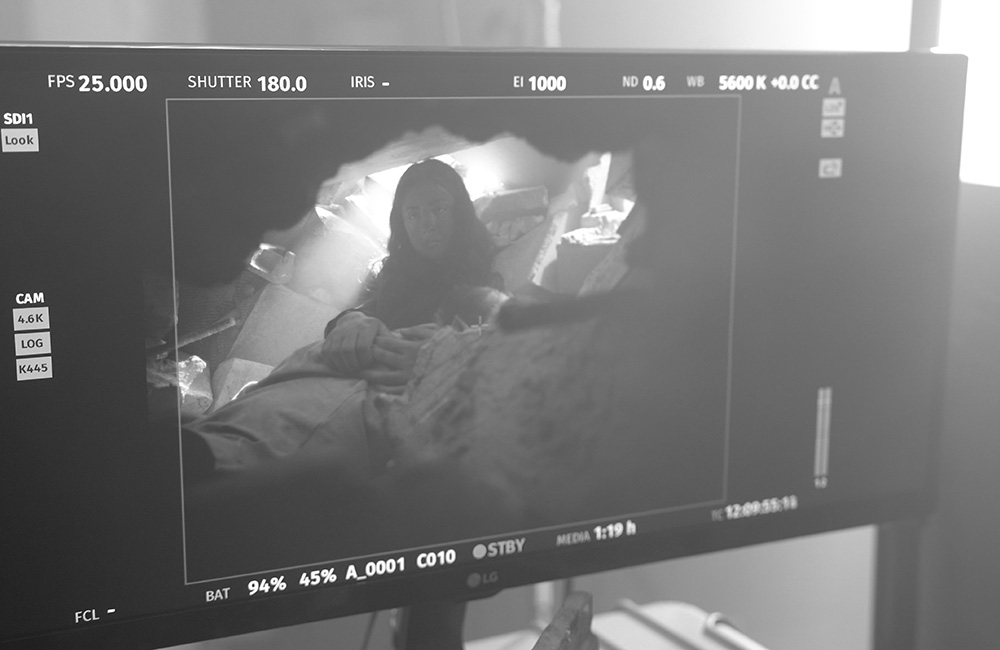The film’s writer and director, Brian Patto, was compelled to create the film after witnessing a tender moment between his own children:
“The idea of the film started from a single moment at home,” says Patto. “One night I heard my son singing a lullaby, and I walked into his room, and there he was, gently putting his baby sister to sleep.
“To witness that pure protective moment between two children … it was beautiful. I kept thinking, ‘what if this was all they had? What if the world around them was falling apart? And that song, that bond was the only thing holding them together’. That became the emotional core.”
Patto took that precious moment between his children, and combined it with his own harrowing experiences during war as a child:
“I was born in Iraq during a time of war, and many of my family members have been affected by various conflicts. The loss of my cousin's five-year-old son during an ISIS raid in Mosul deeply impacted me.
“As a storyteller, I felt a responsibility to bring that raw, unfiltered emotion into the film. I wanted the audience to feel the world through a child's eyes; to connect with that instinct to protect, to hold on, to survive.
“I wanted it to feel claustrophobic, like we were trapped in with them, telling the story through close ups. So we never left their eyes, never stepped away from what they were feeling.”

“I shot it intimately. I kept the camera close, always in with the characters.”
A constructed language to tell a global story
The actors in the film speak a language that doesn’t actually exist. Patto worked with a linguist to create it specifically for the film because, as Patto says, “Conflict doesn't care about country or dialect.”
“Language can be both a bridge and a barrier. From the beginning, I knew I didn't want dialog that anchored the film to a specific place, nationality or political context. So we created a language, one that wasn't designed to be necessarily translated, but carried emotional weight. The goal wasn't comprehension, the goal was connection … and once we freed the story from a real world language, we gave the audience permission to lean in emotionally, not intellectually.
“We worked closely with a linguist to create sounds and rhythms that felt rooted in something ancient and human, familiar enough to be believable, but abstract enough to remain universal. It's a language of tone, of breath, of urgency and tenderness. It speaks in feeling more than in words. And that was always the point: this could be any child anywhere in the world speaking any language.
“That idea shaped every storytelling aspect. It shaped the decision of the filmmaking process, from the cinematography to the pacing, to the performance."

"We wanted the viewer to recognise the experience, not the setting. Because when a child is running from violence, the details don't matter as much as the truth.”
A film meant to provoke
 “I hope this film sparks conversation not just about war or conflicts, but about the children who endure it. I want audiences to sit with that discomfort. To ask not just ‘what if this was my child?’, but ‘why is this happening to children?’ I hope it reminds donors, institutions and decision-makers that every child has the right to safety, to family, to future, no matter where they're born or where they're from.
“I hope this film sparks conversation not just about war or conflicts, but about the children who endure it. I want audiences to sit with that discomfort. To ask not just ‘what if this was my child?’, but ‘why is this happening to children?’ I hope it reminds donors, institutions and decision-makers that every child has the right to safety, to family, to future, no matter where they're born or where they're from.
“What I want people to carry with them is a sense of proximity. These stories aren't distant. They're not fiction, and they're not someone else's problem. I want the film to linger in that space between heartbreak and action, where empathy becomes responsibility.
“And so those in power, those with the means to protect, I would say this: you still have time to do the right thing, to act with urgency. This moment deserves to put humanity before politics. Children don't need speeches. They need protection.”
Patto is right. 2024 was the worst year on record for grave violations committed against children in conflict, and 2025 is expected to be worse, as the number of children living in conflict zones has reached more than 472 million – nearly one in five children globally – the highest proportion since World War II.
This is not just a crisis; it’s a system failure. And it’s time to do something about it.
Photos: Ando Films